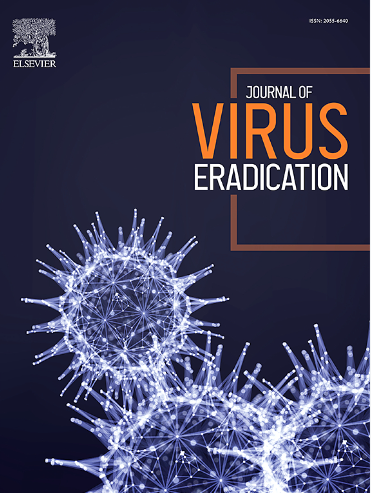Genetic characterization on the nucleoprotein and fusion gene of wild-type measles virus circulating in Shanghai, 2001–2022
IF 2
4区 医学
Q2 IMMUNOLOGY
引用次数: 0
Abstract
Measles is an acute and highly contagious viral disease that poses significant public health challenges globally. Since 2001, continuous virologic surveillance has been conducted in Shanghai, enabling a comprehensive analysis of the evolution of the nucleoprotein (N gene) and fusion gene (F gene) of the measles virus (MeV) over a 21-year period. Between 2001 and 2022, there were a total of 1405 MeV strains isolated by the Shanghai Center for Disease Control and prevention (SCDC), including 6 strains of genotype D8, 8 strains of genotype B3, 12 strains of genotype H1b, and the remaining strains of genotype H1a. Reverse transcription polymerase chain reaction (RT-PCR) was used to amplify the 3′ end of the N gene (450 nt) and the complete sequence of the F gene (1622 nt) from the viral isolates. Sequencing of the RT-PCR products was followed by nucleotide and amino acid phylogenetic analyses. The substitution rates were for the F and N genes in Shanghai were determined to be 0.89 × 10−3 and 2.20 × 10−3 substitutions site/year, respectively.
Globally, the nucleotide and amino acid similarities of the N gene among 13,498 MeV isolates ranged from 89.1 %–100.0 % and 90.2 %–100.0 %, respectively. Notably, the F gene exhibited 16 high-amino-acid-mutation sites, most of which differed among H1a MeV strains compared to the Shanghai-191 vaccine strain. The deletion of the glycosylation site at aa 9–11(NVS) was primarily observed in H1a and H1b of MeV strains. However, critical functional sites in the F gene remained conserved.
In conclusion, the previously predominant indigenous H1a wild-type measles virus (MeV) has not been detected for over two years, with only imported MeV genotypes currently being identified. It is crucial to strengthen the surveillance of MeV genotypes to facilitate the timely identification and containment of imported measles cases, thereby preventing potential outbreaks.
2001-2022年上海市流行麻疹野生型病毒核蛋白及融合基因的遗传特征
麻疹是一种急性和高度传染性的病毒性疾病,对全球公共卫生构成重大挑战。自2001年以来,上海市对麻疹病毒(MeV)进行了持续的病毒学监测,全面分析了21年来麻疹病毒(MeV)核蛋白(N基因)和融合基因(F基因)的演变。2001 - 2022年,上海市疾病预防控制中心共分离MeV病毒株1405株,其中D8基因型6株,B3基因型8株,H1b基因型12株,其余为H1a基因型。利用逆转录聚合酶链反应(RT-PCR)扩增病毒分离株的N基因3′端(450 nt)和F基因全序列(1622 nt)。RT-PCR产物测序后进行核苷酸和氨基酸系统发育分析。在上海地区,F和N基因的替代率分别为0.89 × 10−3和2.20 × 10−3个位点/年。在全球范围内,13,498株MeV分离株的N基因核苷酸和氨基酸相似性分别在89.1% ~ 100.0%和90.2% ~ 100.0%之间。值得注意的是,F基因出现了16个高氨基酸突变位点,其中大部分位点在H1a MeV株与上海191疫苗株之间存在差异。在MeV株的H1a和H1b中,主要观察到aa 9-11 (NVS)糖基化位点的缺失。然而,F基因的关键功能位点仍然是保守的。总之,过去占主导地位的本土H1a野生型麻疹病毒(MeV)已有两年多未被发现,目前只发现了输入性MeV基因型。加强对麻疹病毒基因型的监测至关重要,有助于及时发现和控制输入性麻疹病例,从而预防潜在的疫情。
本文章由计算机程序翻译,如有差异,请以英文原文为准。
求助全文
约1分钟内获得全文
求助全文
来源期刊

Journal of Virus Eradication
Medicine-Public Health, Environmental and Occupational Health
CiteScore
6.10
自引率
1.80%
发文量
28
审稿时长
39 weeks
期刊介绍:
The Journal of Virus Eradication aims to provide a specialist, open-access forum to publish work in the rapidly developing field of virus eradication. The Journal covers all human viruses, in the context of new therapeutic strategies, as well as societal eradication of viral infections with preventive interventions.
The Journal is aimed at the international community involved in the prevention and management of viral infections. It provides an academic forum for the publication of original research into viral reservoirs, viral persistence and virus eradication and ultimately development of cures.
The Journal not only publishes original research, but provides an opportunity for opinions, reviews, case studies and comments on the published literature. It focusses on evidence-based medicine as the major thrust in the successful management of viral infections.The Journal encompasses virological, immunological, epidemiological, modelling, pharmacological, pre-clinical and in vitro, as well as clinical, data including but not limited to drugs, immunotherapy and gene therapy. It is an important source of information on the development of vaccine programs and preventative measures aimed at virus eradication.
 求助内容:
求助内容: 应助结果提醒方式:
应助结果提醒方式:


